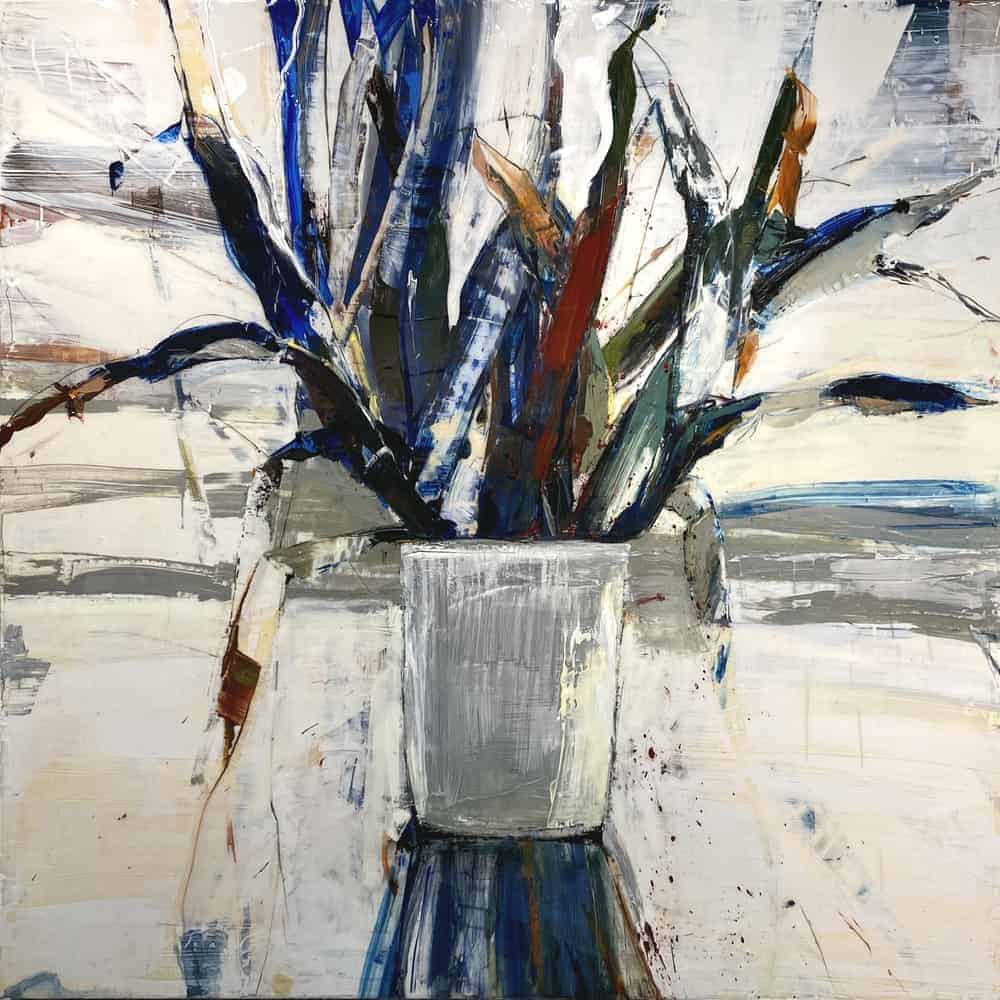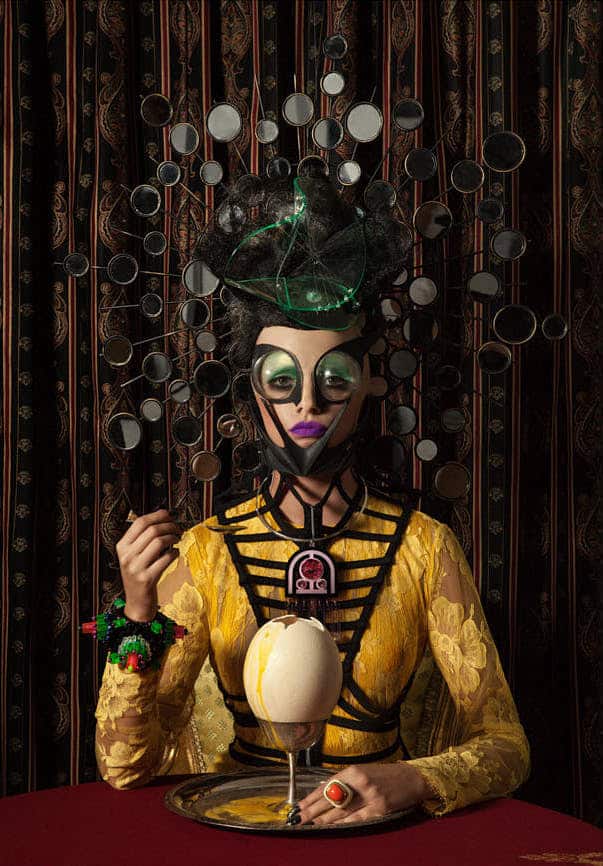ANTONIO GUERRERO
Engaging conversations can spring out of artwork you display in your home or office.
When viewing art, “Engaging” is truly a subjective verb because art that excites and inspires one viewer can completely horrify another. What brings complete connection and wholeness to one individual can either not excite, or worse yet repulse another.
Sourcing meaningful artwork doesn’t have to be overcomplicated. It can often work spontaneously, the same way a good idea hits you in the shower. Visit galleries and museums and remain open to what compels you. It turns out that art that moves you profoundly has a good chance of moving others, maybe not in the same way but affecting them nonetheless, whether they strongly like it or not is the exact reaction and conversation that real art can incite. Letting this principle guide you will help you select work that reflects who you are in an unvarnished and pure way for others to see and react to. If you stay strongly true to who you are and what you love, others will feel your connection and appreciate your bold choice even if they wouldn’t totally understand it.
GREG LOTUS
Photograph on acrylic panel
60 x 40″
“In some cases their [art]work has sustained me during hard times…From my own experience I could testify to the transformative power of art”
―bell hooks

JASON MYERS
Mixed Media on Panel
58 x 48″
Let’s look at some practical ways you can source artwork that has deep and immersive powers for you and in turn opens the well of inspiration and conversation when placed in your living or working space.
The pieces you incorporate into your space don’t have to be “typical” art works. If it calls to you, come closer for a listen. There is a reason you are “engaged”. There’s that word again. Maybe the piece doesn’t even fit your mood board (more about that later), but it’s saying, “Hey, look at me.”
There’s something about the way light reacts to a sculptured surface creating an unexpected silhouette that is hard to ignore.
When you find pieces that aren’t “conventional” but still demand attention, source them! Put them in special areas where they can create an art “experience!”
“People don’t choose paintings, paintings choose people”
If it excites you let it pull you in. You don’t have to over concern yourself with picking the right piece. It is often you’ll find the art is sourcing you. And of course, pieces with strong narratives are the best storytellers. So you go from talking about your last family gathering at the beach to the universal feeling of youth and love that these young people in this painting incite, creating a deep and lasting memory of your own experience that others can and will enjoy. It does it in a different way than a photo you took of your grandchildren can do. A photograph that you take is illustrative of your experience, it is linked to a specific group of individuals and a specific moment in time. A painting of a similar scene is an artist’s expression of the emotion we all feel, it’s universal in that it has meaning for others across all barriers of culture, religion, society and politics. It is a timeless expression and it will command your attention and reaction from others who view it forever. If your art doesn’t do this it’s not worth your attention.
Choose self-reflective, transformative pieces to discuss deeply with your guests
 RENÉ ROMERO SCHULER
RENÉ ROMERO SCHULER
Oil on Canvas 60″ x 54″
In Art On My Mind: Visual Politics by bell hooks, she writes succinctly of the by-product of the art she loved when she said, “ Every artist whose work I have chosen to write about makes art that I value. I have had the good fortune to live with pieces by every artist in this book. In some cases their work has sustained me during hard times. Recently, at the end of a lecture on art and aesthetics at the Institute of American Indian Arts in Santa Fe, I was asked whether I thought art mattered if it really made a difference in our lives. From my own experience, I could testify to the transformative power of art.” bell hooks went on to describe what that transformative artwork did for her.
She was low on funds, but she’d fallen in love with Margo Humphrey’s piece titled The Getaway. Unfortunately, she could only afford the poster of the print. As she had lived with that piece, she was also in a relationship breaking her heart. The Getaway was a buffer against the pain. It provided spiritual renewal when she’d gaze upon the lovers in union at the top of the print and behold their “joyous escape.” bell hooks intentionally placed the piece so she could see it as soon as she woke up every morning; she says of the work, “It worked magic in my soul.”
Choose art that you do not only live with but that lives in you. Choose art that nourishes, encourages, and comforts you in some way. As art gives meaning to the riveting, mediocre, fantastical, imaginative human experience, if a work sustains you, it will at the very least cause your guests to wonder why. “Why” can fan the flames of conversation and is an opportunity to go beyond the paint, texture, material and process to reveal not only the essence of the artist who created it but that of the viewer as well.
Ask yourself, do I value this piece?
Why do I value it?
Can I live with this piece day-to-day?
Am I encouraged by this work?
How do I feel even now as I examine myself in light of the work?
Is there a transformative power here for me?
Does this piece work magic in my soul?
Your responses to these questions are just the start. They should give you direction, a litmus test of sorts, on what belongs with you and what should stay where you’ve beheld it, for a more aligned collector.
Define your personal aesthetic with a mood board
A mood board will help organize your vision by forcing you to articulate the ideas, aesthetic and emotions you’re looking to surround yourself with. In general, mood boards my seem superficial but can be very useful for eeking out your vision, they subconsciously stoke your creative energy and desire, inspiring you toward expressing and documenting who you are and who you want to be. It helps you crystalize the kinds of aspirations and feelings that you value and ultimately seek to find in the artwork, furnishings and objects that you seek to be in your life.
Your mood board is stream of consciousness, it can draw on a number of aesthetics and can include just about anything from objects, images, colors, words and emotions you can think of.
Find a poster board or cork-board and muddle together clippings of whatever you find interesting, exciting and desired. You can use any images that represent the life you want to build, color swatches, textile pieces, images of the textures you want to include, words, and stickers. You can build out your mood board in the physical if you’re more of a kinesthetic, hands-on creative or you can use an app like Canva to collage your images in a neater, faster manner and print out your mood board for hanging and continued inspiration.
By the time your mood board is complete, you should have a clearer idea of who you are and what you should be looking for to enhance your physical surroundings.
As you construct your board, consider how the board may help you define the types of artwork you should be sourcing. Then there is a series of criteria you can use to help you drill down further on the process of collecting.

ESTEBAN LEYVA
A LAS MEMORIAS Y LAS FANTASIAS
Acrylic on Canvas 55″ x 78″
Collection goals to provide thought-prevoking art for you and your guests
What function does your collection have in your space? Do you need to revise the mood after a life changing event? Do you have young children you want to encourage with artwork that either represents them or cultivates their imagination? Do you enjoy figures and silhouettes, architecture, or photography? Futuristic or hyper surrealism? Do you want an ornate collection, or do you lean more towards the minimal with great use of white space?
Do you struggle with depression? Perhaps your collection goals are intended to bring gladness and lighten your emotional load. Sourced artwork might remind you that joy is possible and you deserve it as much as anyone.
Be aware of what your collection provide in terms of comfort, joy and sustainability. And remember what it provides for you, it may also provide for your guests.
 ELENA BOND
ELENA BOND
Oil on Canvas 24″ x 36″
Define your space
Not every piece you want will work for your space. Be honest with what you can live with every day and what might just be too difficult physically or emotionally to be in your daily life. Pre-plan the types of elements you want and leave a lot of wiggle room for the potential to cross paths with artwork that is outside your comfort zone but close to your heart.
Know why you’re buying art as a conversation piece
ANTONIO GUERRERO
The reasons you want to collect a particular piece can range from adoration, transformative power, investment, or support of upcoming artists.
The age of social media and digital imagery has made it increasingly easy to discover breakthrough, avant-garde artists you can support from the grassroots. It’s important however for many collectors to use consultants and galleries to hone their vision and collect pieces that are worthy of their time and attention in their lives. Their job is to lead you to the best fine artists and help you to collect works from them that work for you from every standpoint, emotionally, intellectually, spiritually and physically within the budget you have available.
On your sourcing mission use all your resources. Online galleries are an easy way to see what curators are acquiring. You can even work with experienced galleries like MAC ART to help you source and install artwork for your space that makes sense, especially if you’re intimidated by the process.
On your own, you can pursue and discover new exciting pieces by turning over the proverbial stone and seeing which artists are putting themselves out there. Look for unique works and support the types of artists and pieces you want to see represented!
Not only can you happen on pieces you may not otherwise have found, you can also make invaluable connections with gallerists & artists plus discover and join forums and other groups to connect with like-minded collectors who are also sourcing unique works.
“…I had been taught to hold such images close, to look at art and think about it, to keep art on my mind.”
―bell hooks

John La Huis
Mixed Media on Panel 72″ x 72″
Remember the powered
Sourcing artwork is a simple endeavor once you identify and acknowledge your inspirations and desires. But, of course, sometimes much of these are in flux, in which case you can rely on your heart in the moment to tell you what you need. But without a doubt, the artwork you require will reach you when you put yourself out there.
Art is often like hands reaching out of a piece, feeling for the heartbeat in you, checking your pulse and other vitals, seeking a familiar soul. When you find the pieces you feel, that also feel you.
Those are the ones you source.

FRANK ARNOLD
Oil on Canvas 72″ x 60″


